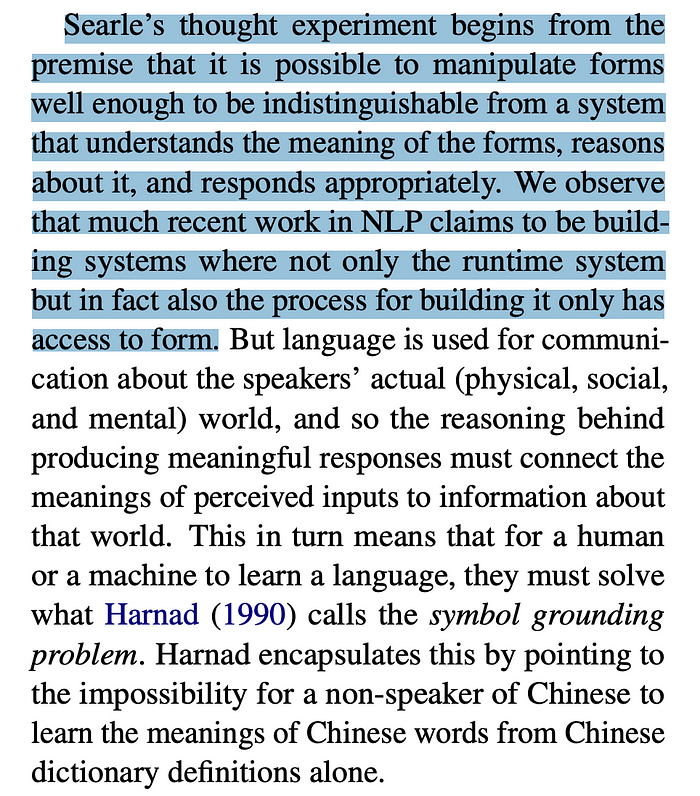

Thought experiment in the National Library of Thailand
source link: https://medium.com/@emilymenonbender/thought-experiment-in-the-national-library-of-thailand-f2bf761a8a83
Go to the source link to view the article. You can view the picture content, updated content and better typesetting reading experience. If the link is broken, please click the button below to view the snapshot at that time.
Thought experiment in the National Library of Thailand
With the advent of ChatGPT, large language models (LLMs) went from a relatively niche topic to something that many, many people have been exposed to. ChatGPT is presented as an entertaining system to chat with, a dialogue partner, and (through Bing) a search interface.* But fundamentally, it is a language model, that is, a system trained to produce likely sequences of words based on the distributions in its training data. Because it models those distributions very closely, it is good at spitting out plausible sounding text, in different styles. But, as always, if this text makes sense it’s because we, the reader, are making sense of it.
In Climbing Towards NLU: On Meaning, Form, and Understanding in the Age of Data (2020) Alexander Koller and I lay out the argument that such systems can’t possibly learn meaning (either “understand” their input or express communicative intent) because their training regimen consists of only the form of language. The distinction between form and meaning in linguistic systems is subtle, not least because once we (humans!) have learned a language, as soon as we see or hear any form in that language, we immediately access the meaning as well.
But we can only do that because we have learned the linguistic system to which the form belongs. For our first languages, that learning took place in socially situated, embodied interactions that allowed us to get an initial start on the linguistic system and the extended through more socially situated, embodied interactions, including some in which we used what we already knew about the language to learn more. For second languages, we might have started with instruction that explicitly leveraged our first language skills.
Nonetheless, when we see a language model producing seemingly coherent output and we think about its training data, if those data come from a language we speak, it’s difficult to keep in focus the fact that the computer is only manipulating the form — and the form doesn’t “carry” the meaning, except to someone who knows the linguistic system.
To try to bring the difference between form and meaning into focus, I like to lead people through a thought experiment. Think of a language that you do not speak which is furthermore written in a non-ideographic writing system that you don’t read. For many (but by no means all) people reading this post, Thai might fit that description, so I’ll use Thai in this example.
Imagine you are in the National Library of Thailand (Thai wikipedia page). You have access to all the books in that library, except any that have illustrations or any writing not in Thai. You have unlimited time, and your physical needs are catered to, but no people to interact with. Could you learn to understand written Thai? If so, how would you achieve that? (Please ponder for a moment, before reading on.)

I’ve had this conversation with many many people. Some ideas that have come up:
- Look for an illustrated encyclopedia. [Sorry, I removed all books with photos, remember?]
- Find scientific articles which might have English loanwords spelled out in English orthography. [Those are gone too. I was thorough.]
- Patiently collate a list of all strings, locating the most frequent ones, and deduce that those are function words, like the equivalents of and, the, or to, or whichever elements Thai grammaticalizes. [Thai actually doesn’t use white space delimiters for words, so this strategy would be extra challenging. If you succeeded, you’d be succeeding because you were bringing additional knowledge to the situation, something which an LLM doesn’t have. Also, the function words aren’t going to help you much in terms of the actual content.]
- Unlimited time and yummy Thai food? I’d just sit back and enjoy that. [Great! But also, not going to lead to learning Thai.]
- Hunt around until you find something that from its format is obviously a translation of a book you already know well in another language. [Again, bringing in external information.]
- Look at the way the books are organized in the library, and find words (substrings) that appear disproportionate in each section (compared to the others). Deduce that these are the words that have to do with the topic of that section. [That would be an interesting way to partition the vocabulary for sure, but how would you actually figure out what any of the words mean?]
Without any way to relate the texts you are looking at to anything outside language, i.e. to hypotheses about their communicative intent, you can’t get off the ground with this task. Most of the strategies above involve pulling in additional information that would let you make those hypotheses — something beyond the strict form of the language.
You could, if you didn’t get fed up, get really good as knowing what a reasonable string of Thai “looks like”. You could maybe even write something that a Thai speaker could make sense of. But this isn’t the same thing as “knowing Thai”. If you wanted to learn from the knowledge stored in that library, you still wouldn’t have access.

When you read the output of ChatGPT, it’s important to remember that despite its apparent fluency and despite its ability to create confident sounding strings that are on topic and seem like answers to your questions, it’s only manipulating linguistic form. It’s not understanding what you asked nor what it’s answering, let alone “reasoning” from your question + its “knowledge” to come up with the answer. The only knowledge it has is knowledge of distribution of linguistic form.
It doesn’t matter how “intelligent” it is — it can’t get to meaning if all it has access to is form. But also: it’s not “intelligent”. Our only evidence for its “intelligence” is the apparent coherence of its output. But we’re the ones doing all the meaning making there, as we make sense of it.
* This is in fact a really bad idea. Chirag Shah and I lay out the reasons in Situating Search (CHIIR 2022) and this op-ed.
Postscript: After this was shared via Twitter and Mastodon, several folks on those sites replied by saying “This is just Searle’s Chinese Room experiment.” Here’s how it’s different:
I’m not asking whether a computer could in principle be programmed to understand. (In fact, by the definition of understanding in Bender & Koller 2020, when you ask a virtual assistant to set a timer, turn on a light, etc and it does, it has understood.) I’m asking whether any entity (person, computer, hyperintelligent deep-sea octopus), exposed only to form, could *learn* meaning i.e. learn to understand.
Searle’s thought experiment presupposes the linguistic rules are already to hand, and asks whether deploying them amounts to understanding (and from there makes conclusions about the possibility of artificial intelligence).
We already pointed this out in Bender & Koller 2020:

For me intelligence is irrelevant/orthogonal: The octopus and the occupant of the National Library of Thailand are posited to be intelligent. A language model is not. The connection to intelligences only comes in because people are asserting intelligence of the GPT models (“sparks of AGI”, “LaMDA is sentient”, “slightly conscious”, yadda yadda) on the basis of their linguistic output. The National Library of Thailand thought experiment is meant to show that for the parlour trick that it is.
In other words, I’m writing in the context of 2019–2023 where it has become very clear that we have to guard against our tendency to attribute a mind behind the words, once the words are fluent enough.
Recommend
About Joyk
Aggregate valuable and interesting links.
Joyk means Joy of geeK